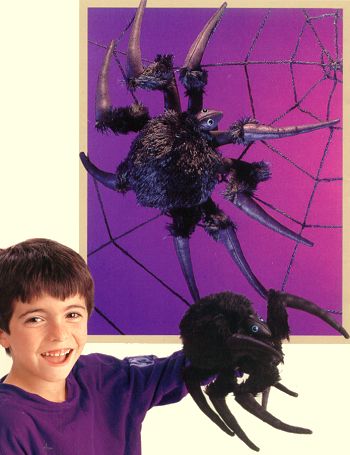|
|
1. The biggest spider in the world is the Goliath Bird
Eating Tarantula (Theraphosa leblondi) that literally eats
birds. They are found in North Eastern South America. They
are reportedly the size of a dinner plate.
2. Located in Borneo, the smallest spider is a Mygalomorph
Spider that is the size of a pinhead.
3. The spider silk of an orb weaver spider has the tensile
strength of steel! But because they produce so little of it
and they are territorial it is impractical to keep the
spiders and harvest the spider silk. It was once suggested
to make bullet proof vests out of this spider's silk.
4. The most venomous spiders in the United States are the
Black Widow and the Brown Recluse spiders. Although these
spiders are highly venomous and can bite through human skin
if threatened, there hasn't been a case of these spiders
causing death in two decades. Their bites can be very
painful and damaging, however.
5. The most venomous spider in Australia is actually the
Male Funnel-web Spider, which is unusual because it is
usually the female of the spider species that is more
venomous.
6. The hunting spiders that run down their prey rather than
spinning webs or laying in wait are very interesting. They
have developed many ways to catch their prey, from using
camouflage to blend into their environment to being able to
jump more than a yard in one jump. The hunting spider knows
what to do when it comes to getting a meal!
7. Some spiders can walk on water! There are actually
fifteen spider species that perform this feat. Among them is
the Fisher Spider (Dolomedes triton) which not only walks on
water but runs very fast on water after prey or other Fisher
Spiders threatening its territory.
8. Some spiders can fly! The Sheet Web Spider literally
makes a balloon of sorts out of some webbing that it spins
from its abdomen, the balloon then lifts it into the air to
soar along on the breezes.
9. Some spiders use pheremones on their webs to attract
bugs! The Bolas Spider drops a strand of sticky silk that is
impregnated with a substance similar to the pheremone that
moths use to attract mates. When a moth comes courting, the
Bolas swings its sticky lariat and captures its meal.
10. Some spiders hiss or click to appear more dangerous to
predators! The tarantula is famous for its threatening hiss
that can be heard by humans from yards away.
11. Most spiders will eat other spiders. How is that for
having your relatives for dinner?
12. Some humans actually eat spiders and some consider the
Tarantula a delicacy when roasted.

Still more facts about Spiders
1. Spiders have their own predators. There is a wasp that
actually paralyzes and buries the spider alive, laying its
eggs within the spider to hatch and eat the spider literally
from the inside out.
2. Spiders have six to eight eyes and while some are
extremely near-sighted and use their fine hairs to detect
their surroundings, there are other spiders that have very
well developed eyes and have been known to distinguish
pictures of prey or other spiders on a television and
respond to them.
3. Some tribes of humans have found a way to use the
spider's web to catch their own dinner. In the South Pacific
the islanders have encouraged the spiders there to create
webs between two bamboo shoots, which makes a net that the
people then use to catch fish.
4. Each spider disposes of about two thousand insects a
year, so they are actually good to have in your garden or
home. However they usually do not last long in these locales
because people find them creepy and kill them without
regard. Spiders are found all over the world in all sorts of
habitats, from the seashore to the desert - on the ground,
under rocks, on plants, in trees, in caves, and even on
water.
5. All spiders are venomous. If you are bitten by a spider
it is recommended by the poison control center to clean the
wound, put antibiotic on it and bandage the area. If the
bite does not go away in a week or you develop other
symptoms like fever, swelling or disorientation it is
recommended that you see a doctor.
6. The urban legend that a Daddy Longlegs is the most
poisonous spider but has a mouth too small to bite a human
is just that, a legend. The species commonly referred to as
Daddy Long Legs, the Harvestman, isn't actually a spider and
has no venom at all.
7. Insecticides are not effective against spiders. Spiders
are resistant to poisons and once an area has been sprayed,
often the spider will come right back to spin its webs.
Other insects like termites are also resistant, but spiders,
their natural predators, actually will kill them for you by
hunting inside your home.
8. Spiders are not insects, they are Arachnids. But then not
all Arachnids are spiders, so be careful to be clear about
what you are referring to.
9. Also, spiders are not the only creatures that have eight
legs, so not all eight legged creatures are spiders. Try to
use the Internet or a book to identify the wild insects and
Arachnids you come across, preferably before you smash them.
10. Spiders eat their prey, they usually do not just suck
the juice out of their meals and leave the desiccated husk
in the cocoon. Most spiders eat everything off of their prey
that they can digest.
More on Spiders &
Invertebrates
These Stuffed Spiders and Tarantulas are full of Pleasure

|